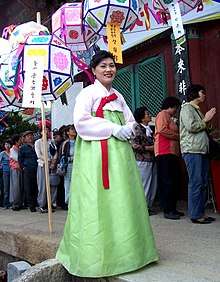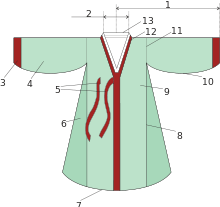Jeogori
The jeogori (Korean: 저고리 Korean pronunciation: [t͡ɕʌ̹ɡo̞ɾi]) is a basic upper garment of the hanbok, a traditional Korean garment, which has been worn by both men and women. Men usually wear the jeogori with a baji or pants while women wear the jeogori with chima, or skirts. It covers the arms and upper part of the wearer's body.[1][2][3]
| Jeogori | |
 A white jeogori with red goreum (ribbon) | |
| Korean name | |
|---|---|
| Hangul | 저고리 |
| Revised Romanization | jeogori |
| McCune–Reischauer | chŏgori |
Etymology
The jeogori has been worn since ancient times and went by a variety of names such as yu (유, 襦), boksam (복삼, 複杉), and uihae (위해, 尉解) in the Three Kingdoms period (57 BC - 668 AD). Although it is unknown when the term jeogori began to be used to refer the garment, it is assumed to have appeared in the late Goryeo period around King Chungnyeol's reign. The first historical document to mention the jeogori is Cheongjeonui (천전의, 遷奠儀) for Queen Wongyeong (원경왕후), which was a funeral ceremony for carrying the coffin out of the palace. The document written in 1420 during the second reign of Sejong the Great records jeokgori (赤古里) and danjeokgori (短赤古里). However, it is not clear whether the record is a hanja (Chinese character) transliteration of a Korean word or Mongolian influence. Before the Goryeo period, such an upper garment was referred to as "uihae" (위해, 尉解) in Silla. As the uihae was a transliteration of the Silla language, dialect forms such as uti and uchi still remain to present.[1][2][3]
Composition

Traditionally, a Jeogori is made out of silk, hemp or ramie.[4][5] Modern Korean designers sometimes use other materials such as lace.[4][6]
The basic form of a Jeogori consists of gil, git, dongjeong, goreum and sleeves somae. Gil (길) is the large section of the garment in both front and back side and git (깃) is a band of fabric that trims the collar. Dongjeong (동정) is a removable white collar placed over the end of the git and is generally squared off. The goreum (고름) are coat strings attached to the breast part to tie the jeogori.[7] Women's jeogori may have kkeutdong (끝동), a different colored cuff placed on the end of the sleeves. The form of jeogri has been changed as time goes by.[3]
There are several types of jeogori according to fabric, sewing technique, and shape.[3]
History
The earliest known depictions of the jeogori are on Goguryeo murals.[8]
The original silhouette for jeogori came from Chinese Tang influence in the Silla Dynasty (668–935 CE).[4][9] Previously in Korea, jackets were worn over bottom garments.[4] Like clothing in the Tang dynasty, tops became shorter, and were tucked into bottoms.[4]
During the Koryo Period (918–1392), jeogori became shorter, with slimmer sleeves.[4]
In the Joseon Period, jeogori lengths and style fluctuated depending on current fashion and social standing.[4]
In the 16th century, women's jeogori were long, wide, and covered the waist.[8] The length of women's jeogori gradually shortened: they were approximately 65 cm in the 16th century, 55 cm in the 17th century, 45 cm in the 18th century, and 28 cm in the 19th century, with some as short as 14.5 cm.[8] A heoritti (허리띠) or jorinmal (졸잇말) was worn to cover the breasts.[8] The trend of wearing a short jeogori with a heoritti was started by the gisaeng and soon spread to women of the upper class.[8] Among women of the common and lowborn classes, a practice emerged in which they revealed their breasts after childbirth to proudly indicate that they had given birth to a son, i.e., a male heir.[10]
Modern Styles
In contemporary Korea, the sumptuary laws within different social classes were lifted and colors, decorations, and fabrics that were exclusive to the upper classes were open to all classes. This allowed for the growth of diverse traditional design elements in hanbok styles. However, in the 20th and 21st centuries, traditional Korean clothing has not been worn every day by most people.[4] Hanbok became more reserved for special events, such as ceremonial or bridal wear, which carries onto current time.[4] During their own engagement celebrations, women may wear pink jeogori.[11] After they are married, women may wear indigo jeogori.[11] Additionally, modern silhouettes are commonly slimmer and more simplified then historical styles.[4][9]
Gallery
 Jeogori for women
Jeogori for women


References
- 저고리 (in Korean). Empas / EncyKorea. Retrieved 2008-09-29.
- 저고리 (in Korean). Doosan Encyclopedia. Retrieved 2013-10-15.
- 저고리 (in Korean). Empas / Britannica. Retrieved 2008-09-29.
- Encyclopedia of Modern Asia. Ed. Karen Christensen and David Levinson. Vol. 2. New York, NY: Charles Scribner's Sons, 2002. p120-121. Web.
- "V&A · Jogakbo – traditional Korean patchwork". Victoria and Albert Museum. Retrieved 2019-05-10.
- "Hanbok ensemble with black lace Yeonan Kim Clan jacket and cream skirt - Victoria & Albert Museum - Search the Collections". m.vam.ac.uk. Retrieved 2019-05-10.
- "Traditional clothing". KBS World. Archived from the original on 2008-03-17. Retrieved 2013-10-17.
- 허윤희. "조선 여인 저고리 길이 300년간 2/3나 짧아져". 조선닷컴 (in Korean). Retrieved 6 September 2019.
- Encyclopedia of Clothing and Fashion. Ed. Valerie Steele. Vol. 1. Detroit, MI:Charles Scribner's Sons, 2005. p82-85. Web.
- Han, Hee-sook (2004). "Women's Life during the Chosŏn Dynasty". International Journal of Korean History. 6 (1): 142. Retrieved 6 September 2019.
- "Jacket". Th Victoria and Albert Museum. Retrieved May 9, 2019.
- Lee Ho-jeong (2007-05-07). "Clothing with stories of fertility and faith". JoonAng Daily.
External links
| Wikimedia Commons has media related to Jeogori. |